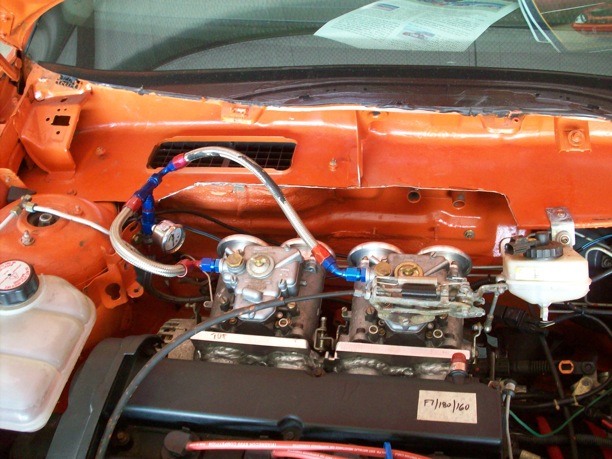2009
Speed Week is
approaching. We entered the Focus only this year. The plan
is to bend all our efforts on this car and try for the
record. I don't think we'll be the only ones trying,
however.
We decided to make one more stab at getting the engine
running properly with the Weber carbs. The intake manifold
appears to be the one sold by Burton Power in England. It
is intended for use with smaller Webers than we are
running. It looks like JBA modified this intake to fit the
larger carbs by filling the mounting holes and re-drilling
it for the bigger carbs. They didn't match all that well
but the big problem came when I attempted to install new
isolating mounts that supposedly reduce vibration in the
float chambers. These mounts are plastic castings with
o-ring grooves on each side. Unfortunately, with the carbs
moved aside for linkage clearance, there was no meat left
on the flange for the o-rings to seat.
We cut the manifold and welded on a machined plate with
mounting holes for the 48 DCO/SP carbs. To move the intake
resonance tuning point up a little in rpm, we shortened it
by about 3/4". It took a bit of hacking to get clearance
for the linkage and the alternator but it does fit.

The engine is running. I've setup the carbs to
factory-stock jetting as a baseline and it actually idles
now! This is a first. I have built a sheet metal plenum
that bolts to the carbs under the airhorns. Not
spectacularly pretty but I think it will help.
We ran the car on a chassis dyno recently. 190 HP at the
front wheels with a smooth air/fuel curve. I could actually
tune it richer and leaner with the jets (another first)! If
you figure 15% loss through the drivetrain, this implies
about 220 HP at the engine, close to what I was expecting.
We have a basic tune for Bonneville now and a box of jets
and air bleeds to lean it out as needed for the salt. The
computer says ... well, it says we can do it. All we have
to do is, well, do it. We'll know in a few weeks ...˙
Well, the best-laid plans ... The car ran strong in the
lower gears but, for no reason that we could figure out on
the salt, the engine kept getting leaner and leaner in each
gear. We first thought it was fuel delivery so we changed
to a bigger fuel pump, raised the fuel pressure way above
what Weber recommends, raised the float levels. All to no
avail. Our best run was 139 mph. Eventually, the lean
mixture took it's toll: two cylinders were down to 90-95
psi compression. We were done.
This pretty much spells the end of the Webers. My best
guess after months of thinking about it is that the fuel in
the float bowls must have areated from the vibration,
causing an excess of air in the air/fuel mixture coming out
the venturis. This would explain why the air/fuel ratio
increased over time. The solution -- FUEL INJECTION! Aaryn
wants to end up turbo-charging the car and running in blown
gas coupe class down the road so going to a turbo-style
injection setup now will only facilitate that. Now, all we
need is a lot of money!



